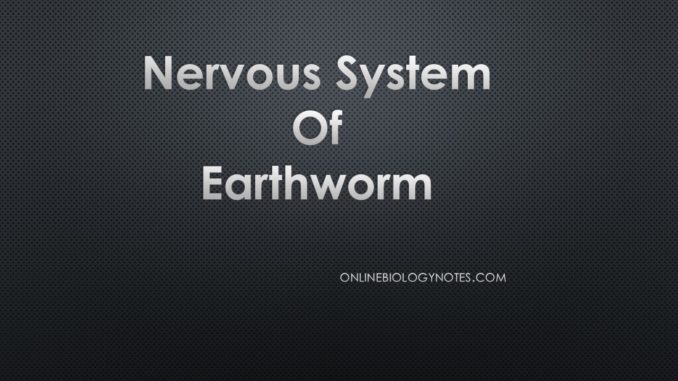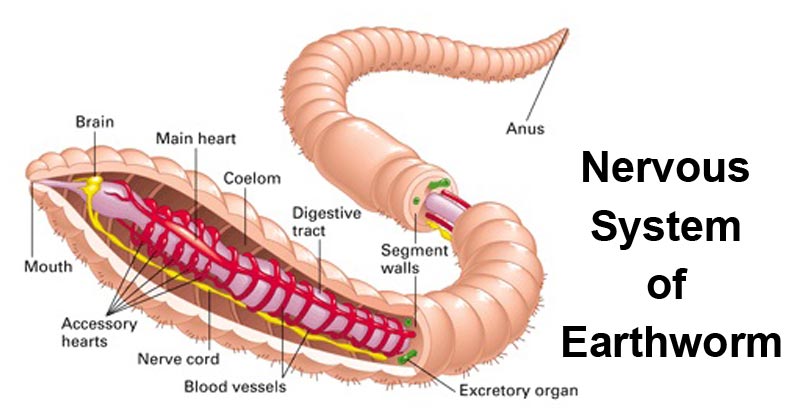
Do earthworms have nervous system?
- Earthworm has a well-developed nervous system.
- The nervous system is metamerically segmented.
- The nervous system is divisible into central, peripheral and autonomic nervous system (sympathetic nervous system).

Central nervous system of earthworm:
- It includes a nerve ring and a nerve cord.
i) Nerve ring of earthworm :
- Nerve ring is an oblique ring around the pharynx in 3rd and 4th segments.
- Its mid-dorsal part comprises of a pair of small and fused supra-pharyngeal ganglia, also called cerebral ganglia or brain.
- Likewise, its mid ventral part is formed of a pair of small and fused sub-pharyngeal ganglia.
- The dorsal and ventral ganglionic parts are connected by a pair of loop-like circum-pharyngeal or peri-pharyngeal connective to complete the ring.
ii) Nerve cord of earthworm:
- Nerve cord arises from the sub-pharyngeal ganglia.
- It extends behind up to the posterior end of body in mid ventral axis beneath the ventral vessel.
- Both cords appear as a single nerve cord as they are fused and enclosed in a common sheath.
- Starting from the 5th segment behind, the nerve cord has a ganglionic swelling in the posterior part of each segment. It is known as segmental ganglion.
- Histologically, the double nerve cord is solid and formed of nerve cells and fibres.
- Nerve cord is surrounded by epineurium (a common sheath of connective tissue).
- Outside epineurium, there is a layer of longitudinal muscle fibers.
- This is finally surrounded by a layer of visceral peritoneum.
- Nerve cells are mainly present in ventral and lateral sides of the nerve cord.
- Nerve fibers are mainly present in dorsal and middle portion of nerve cord.
- Nerve fibers are of two types ordinary fibers and giant fibers/neurocords.
- Four peculiar giant fibers (one median, one sub-median, and 2 laterals) are found mid-dorsal to the ventral nerve cord.
- Giant fibers functions for the rapid conduction of impulses throughout the nerve cord.
- In lateral giant fibers, impulse is conducted antero-posteriorly.
- However, in median and sub-median fibers, the impulse is conducted postero-anteriorly.
Peripheral nervous system (PNS) of earthworm:
- All nerves arise from CNS and supply to various parts of body.
- All the nerves present in earthworm are of mixed type as they contain both afferent and efferent nerve fibres and adjustors (association neurons).
- From the cerebral ganglia/brain, 8-10 pairs of nerves arise.
- From the peri-pharyngeal or circum-pharyngeal connectives, 2 or 3 pairs of nerves arise.
- From the sub-pharyngeal ganglia, 3 pairs of nerves arise.
- Each segmental ganglion of nerve cord gives out 3 pairs of nerves in each segment.
- First pair arises just in front of setal ring while the other 2 pairs arise closely but behind setal ring.
Autonomic nervous system (ANS) of earthworm:
- ANS of Pheretima posthuma possess sympathetic nervous system only with extensive nerve plexus that are connected to the nerves from circum-pharyngeal connectives.
Nervous activities in Earthworm:
- All earthworm operations are regulated by the nervous system, but not necessarily by the brain.
- They have both sensory and motor neurons, like larger animals.
- Sensory fibers start in the epidermis from sensory cells or receptor organs and end in fine branches in the ventral nerve cord.
- Similar branches of motor fibers arise near the branches of the cord and form a synapse with them, running outward and ending in muscles.
- Stimuli or sensory impulses are conducted to the ventral nerve cord from the receptor through sensory fibers, from where motor impulses are reflected along efferent fibers to contracting muscles.
- A simple reflex arc forms the circuit of stimuli or impulses.
- The motion of the circular and longitudinal muscles is coordinated, so the contraction of one causes the other to relax.
- Giant fibres of nerve cord conduct impulses more rapidly than other fibres, resulting in the sudden contraction of the entire earthworm body when strongly stimulated at one point.
